Physical and Mechanical Properties of Rural-Road Pavement Concrete in South Korea Containing Air-Cooled Blast-Furnace Slag Aggregates
Abstract
:1. Introduction
2. Materials, Mix Proportions, and Test Methods
2.1. Materials
2.2. Mix Proportions
2.3. Test Methods
2.3.1. Physical Properties of the Air-Cooled Slag Aggregates
2.3.2. Environmental-Hazard Testing of the Air-Cooled Slag Aggregates
2.3.3. Slump Value and Air Content
2.3.4. Compressive Strength
2.3.5. Flexural Strength
2.3.6. Splitting Tensile Strength
2.3.7. Chloride Ion Penetration
3. Results
3.1. Physical Properties of the Air-Cooled Slag Aggregates
3.2. Environmental-Hazard Testing of the Air-Cooled Slag Aggregates
3.3. Slump Values and Air Contents
3.4. Compressive Strength
3.5. Flexural Strength
3.6. Splitting Tensile Strength
3.7. Chloride Ion Penetration
4. Conclusions
- As a result of evaluating the physical properties of the air-cooled slag aggregate produced as a concrete aggregate, the quality standards (KS F 2527) of the blast-furnace slag aggregate for concrete were satisfied.
- As a result of conducting a dissolution test in accordance with the Waste Management Act of the Ministry of Environment of the Republic of Korea and the Japanese standard JIS K 0058 to evaluate the environmental properties of the air-cooled slag aggregate, it was found that there was no effect on the dissolution of hazardous substances, as all the standards were satisfied.
- The slump and air-content values of the experimental mixtures met the targeted performance criteria. However, the slump decreased, and the air content increased, with increasing amount of air-cooled slag aggregate. This result was because the air-cooled slag aggregate had pores on the surface compared to the natural aggregate, which increased the absorption of mixed water and the contents of air.
- The compressive, flexural, and splitting tensile strengths of the experimental mixtures met the targeted performance criteria based on the design criteria of the Korea Ministry of Agriculture’s Agricultural Production Infrastructure Maintenance Business Plan and the Korea Expressway Corporation’s Highway Construction Specialized Specifications. However, as the content of the air-cooled slag aggregate increased, the strength decreased, and the coarse air-cooled slag aggregate had a greater effect on the strength reduction than the fine air-cooled slag aggregate.
- The chloride ion penetration of the experimental mixtures met the targeted performance criterion of the design criteria of the Korea Ministry of Agriculture’s Agricultural Production Infrastructure Maintenance Business Plan and the Korea Expressway Corporation’s Highway Construction Specialized Specifications. In addition, the amount of chlorine ion penetration increased as the content of the air-cooled slag aggregate increased.
Author Contributions
Funding
Institutional Review Board Statement
Informed Consent Statement
Data Availability Statement
Conflicts of Interest
References
- Lee, J.M.; Choi, H.K.; Yoo, T.J.; Kim, Y.M. Establishing a Resource Circulation Network through the Use of Blast Furnace Slag Ready-Mix Concrete Aggregate; EIP Report; Korea Industrial Complex Corporation: Dae-gu, Korea, 2017. [Google Scholar]
- Jeon, J.G.; Jin, S.J.; Kim, D.H. Present Status and Recycling Technology for Slag in Korea. J. Korean Recycl. Constr. Resour. Inst. 2013, 8, 8–10. [Google Scholar]
- Choi, S.W.; Kim, V.; Jang, W.S.; Kim, E.Y. The Present Situation of Production and Utilization of Steel Slag in Korea and Other Countries. Mag. Korea Concr. Inst. 2007, 19, 28–33. [Google Scholar]
- Korea Waste Association. Study on the Improvement of the Steel Slag Recycling System; Korea Ministry of Environment: Sejong, Korea, 2011. [Google Scholar]
- Ryu, D.H.; Choi, S.W. The Prospect for Utilization of Blast Furnace Slag as Concrete’s Aggregate. J. Korean Recycl. Constr. Resour. Inst. 2010, 5, 24–32. [Google Scholar]
- Mun, H.Y.; Jeong, S.J.; Lim, N.K. Aggregate for concrete using industrial by-products and waste-blast furnace slag aggregate. Mag. Korea Concr. Inst. 1997, 9, 18–22. [Google Scholar]
- Ryu, C.S. Actual State of Recycled Aggregate Utilization & Improving Way of Construction Waste Recycle. J. Korean Recycl. Constr. Resour. Inst. 2007, 3, 23–26. [Google Scholar]
- Park, M.S.; Kim, Y.S. A Study on the Sulfate Attack Resistance of Concrete Using EAF Slag as Fine Aggregate. J. Korean Inst. Archit. Constr. 2009, 9, 81–87. [Google Scholar]
- Song, T.Y.; Lee, K.C.; Lee, W.P. Plan for Expanded Recycling of Recycled Aggregates as Construction Materials. J. Korean Recycl. Constr. Resour. Inst. 2016, 11, 14–17. [Google Scholar]
- Yoo, Y.S.; Choi, H.B.; Bang, J.H.; Chae, S.C.; Kim, J.W.; Kim, J.M.; Lee, S.W. CO2 Sequestration and Utilization of Calcium-extracted Slag Using Air-cooled Blast Furnace Slag and Convert Slag. Appl. Chem. Eng. 2017, 28, 101–111. [Google Scholar]
- Lee, D.G.; Min, G.H.; Jeong, Y.W. A Study on the Reduction of Drying Shrinkage of Mortar and Concrete Using the Expandability of Rapidly Cooled Slag Fine Aggregate. J. Korea Acad. Ind. Coop. Soc. 2015, 16, 3511–3517. [Google Scholar]
- Lee, S.T.; Park, G.P. Mechanical Properties and Durability of Concrete Incorporating Air-Cooled Slag. J. Korea Acad. Ind. Coop. Soc. 2017, 18, 356–363. [Google Scholar]
- Lim, H.S.; Lee, H.S. Experimental Study on Evaluation on Volume Stability of the Electric Arc Furnace Oxidizing Slag Aggregate. J. Korea Inst. Struct. Maint. Insp. 2017, 21, 78–86. [Google Scholar]
- Jeong, W.K.; Kim, Y.S.; Bae, J.O. Development and application examples of high-performance concrete pavement repair materials using fine aggregates of oxidized slag of an electric furnace, a by-product of the steel industry. Korean Soc. Road Eng. Road 2012, 14, 39–50. [Google Scholar]
- De MatosaJade, P.R.; Taísa, C.P.O.; Diego, M.M.; Philippe, C.M.; Rudiele, J.P.G.; Pilarb, A.S.R. Use of air-cooled blast furnace slag as supplementary cementitious material for self-compacting concrete production. Constr. Build. Mater. 2020, 262, 102–120. [Google Scholar] [CrossRef]
- Verian, K.P.; Behnood, A. Effects of deicers on the performance of concrete pavements containing air-cooled blast furnace slag and supplementary cementitious materials. Cem. Concr. Compos. 2018, 90, 27–41. [Google Scholar] [CrossRef]
- Ozbakkaloglu, T.; Gu, L.; Pour, A.F. Normal- and high-strength concretes incorporating air-cooled blast furnace slag coarse aggregates: Effect of slag size and content on the behavior. Constr. Build. Mater. 2016, 126, 138–146. [Google Scholar] [CrossRef]
- Abdel-Ghani, N.T.; El-Sayed, H.A.; El-Habak, A.A. Utilization of by-pass cement kiln dust and air-cooled blast-furnace steel slag in the production of some “green” cement products. HBRC J. 2018, 14, 408–414. [Google Scholar] [CrossRef] [Green Version]
- Smith, K.D.; Morian, D.A.; Van Dam, T.J. Use of Air-Cooled Blast Furnace Slag as Coarse Aggregate in Concrete Pavements—A Guide to Best Practice; FHWA-HIF-009; Federal Highway Administration: Washington, DC, USA, 2012.
- Min, K.S.; Park, Y.K.; Lee, J.H.; Kim, H.W.; Jeong, K.Y.; Yoon, K.W. A Study on Application of PHC Pile Concrete of Aggregate using Air-cooled Blast Furnace Slag Aggregate. In Proceedings of the Korea Concrete Institute 2014 Spring Conference, Korea Concrete Institute, Jeju, Korea, 29–30 May 2014; Volume 26, pp. 341–342. [Google Scholar]
- Korea Ministry of Agriculture, Food and Rural Affairs. Agriculture’s Agricultural Production Infrastructure Maintenance Business Plan’s Design Criteria; Korea Ministry of Agriculture, Food and Rural Affairs: Sejong, Korea, 2007.
- Korea Expressway Corporation. Construction Material Quality and Standard for Highway Construction; Korea Expressway Corporation: Kimcheon, Korea, 2005. [Google Scholar]
- KSF 2527, Concrete Aggregate; Korea Standards Association: Seoul, Korea, 2020.
- Korea Ministry of Environment. Water Pollution Process. Test Standards; Ministry of Environment: Sejong, Korea, 2021.
- JIS K 0058-1. Test Methods for Chemicals in Slags Part. 1: Leaching Test. Method (FOREIGN STANDARD); Japanese Standards Association: Tokyo, Japan, 2005. [Google Scholar]
- ASTM C143/C143M, Standard Test Method for Slump of Hydraulic-Cement Concrete; American Society for Testing and Materials: Philadelphia, PA, USA, 2020.
- ASTM C231/C231M, Standard Test Method for Air Content of Freshly Mixed Concrete by the Pressure Method; American Society for Testing and Materials: Philadelphia, PA, USA, 2017.
- ASTM C39/C39M, Standard Test Method for Compressive Strength of Cylindrical Concrete Specimens; American Society for Testing and Materials: Philadelphia, PA, USA, 2017.
- ASTM C78/C78M, Standard Test Method for Flexural Strength of Concrete (Using Simple Beam with Third-Point Loading); American Society for Testing and Materials: Philadelphia, PA, USA, 2021.
- ASTM. ASTM C496/C496M. Standard Test Method for Splitting Tensile Strength of Cylindrical Concrete Specimens; American Society for Testing and Materials: Philadelphia, PA, USA, 2011. [Google Scholar]
- ASTM. ASTM C1202. Standard Test Method for Electrical Indication of Concrete’s Ability to Resist. Chloride Ion. Penetration; American Society for Testing and Materials: Philadelphia, PA, USA, 2012. [Google Scholar]
- Park, S.B. Construction Materials; Muneundang: Seuol, Korea, 2010. [Google Scholar]
- Shin, K.S.; Lee, B.K.; Kim, K.Y. Durability of Concrete Using Blast Furnace Slag Powder. J. Korean Recycl. Constr. Resour. Inst. 2012, 7, 13–17. [Google Scholar]
- Lee, H.J.; Se, J.I.; Ryu, S.W. Bond Behavior of Concrete According to Replacement Ratio of Fly Ash and Compressive Strength of Concrete. J. Korean Recycl. Constr. Resour. Inst. 2016, 4, 19–24. [Google Scholar]
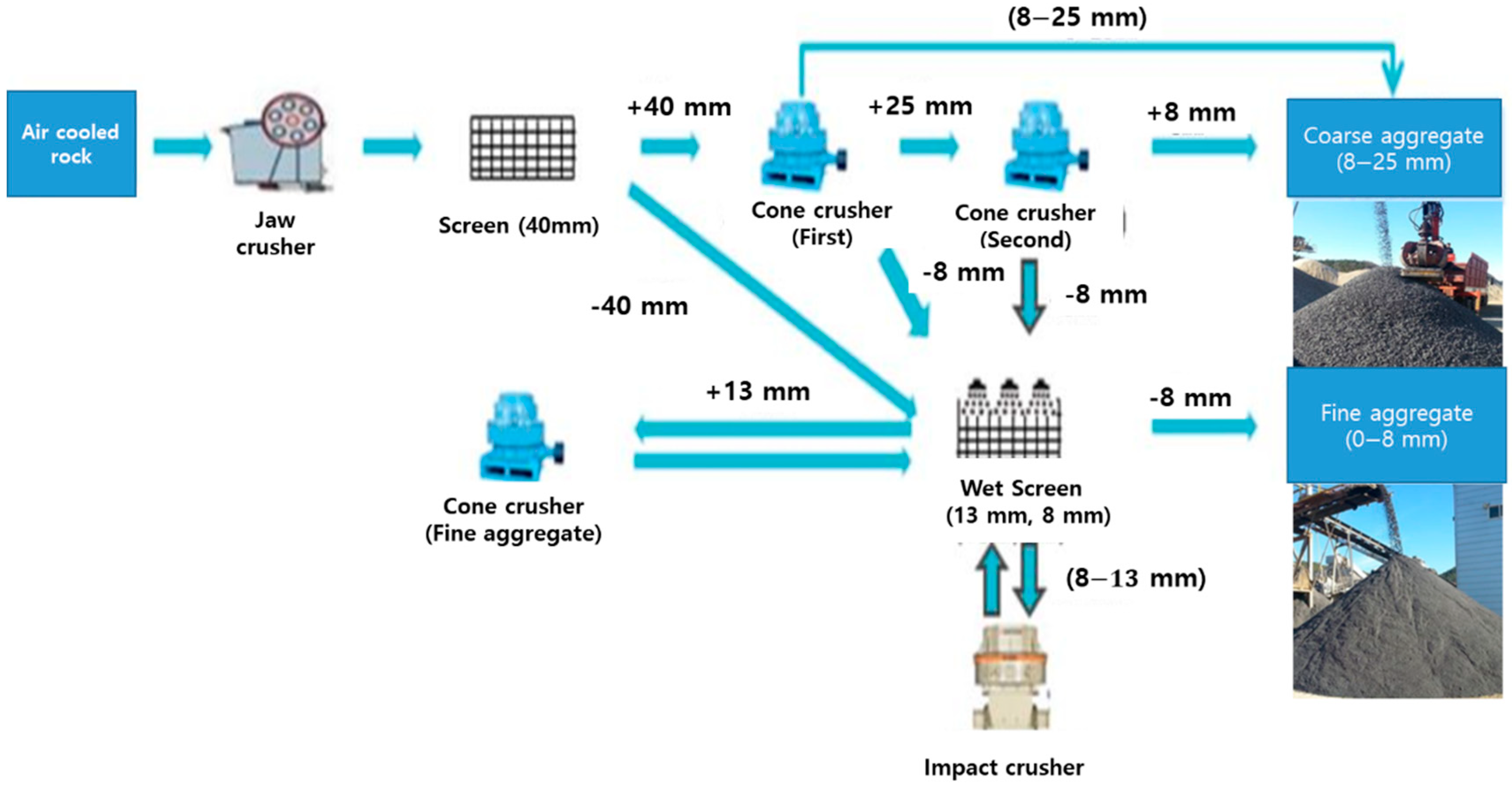
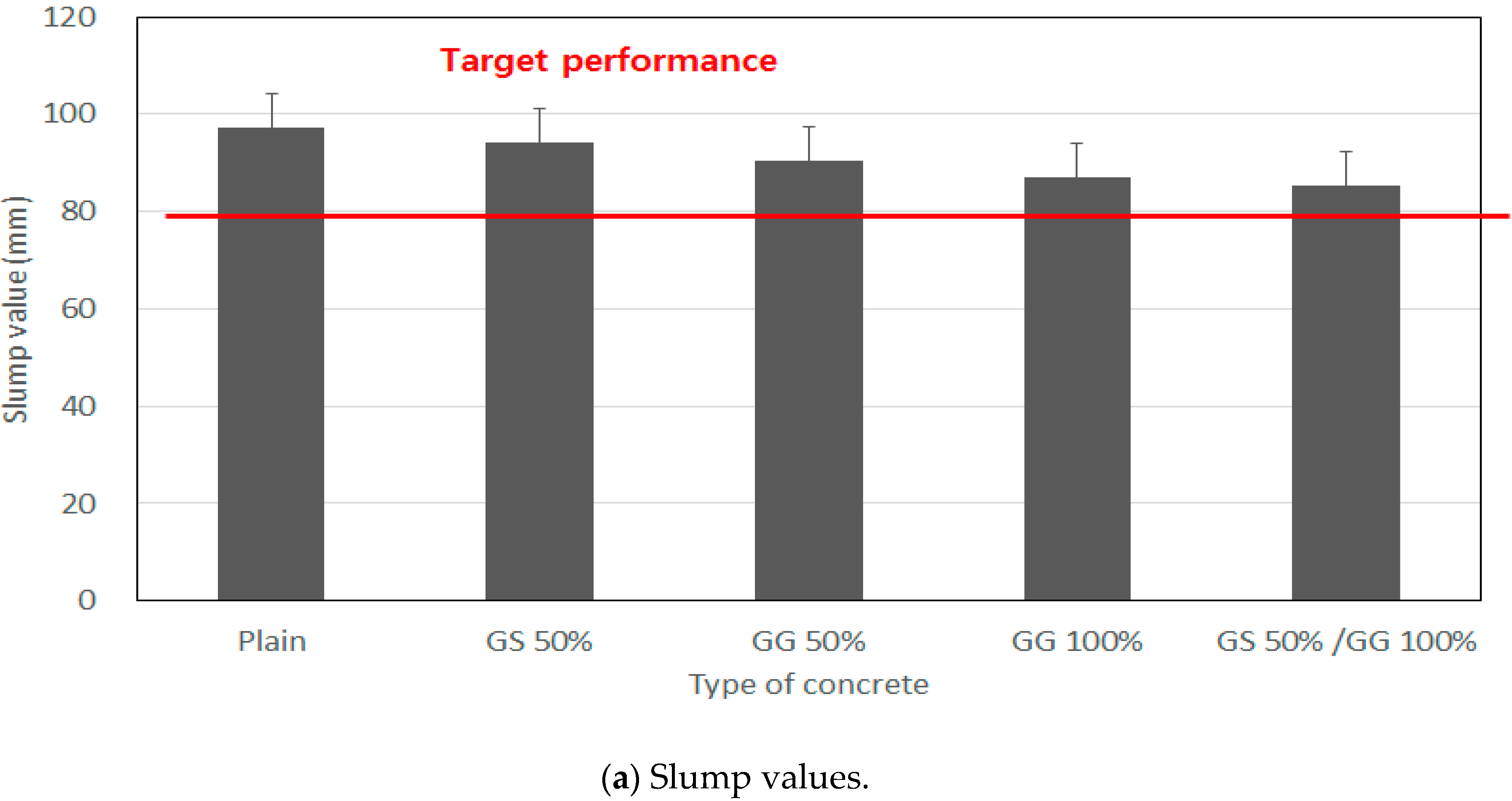
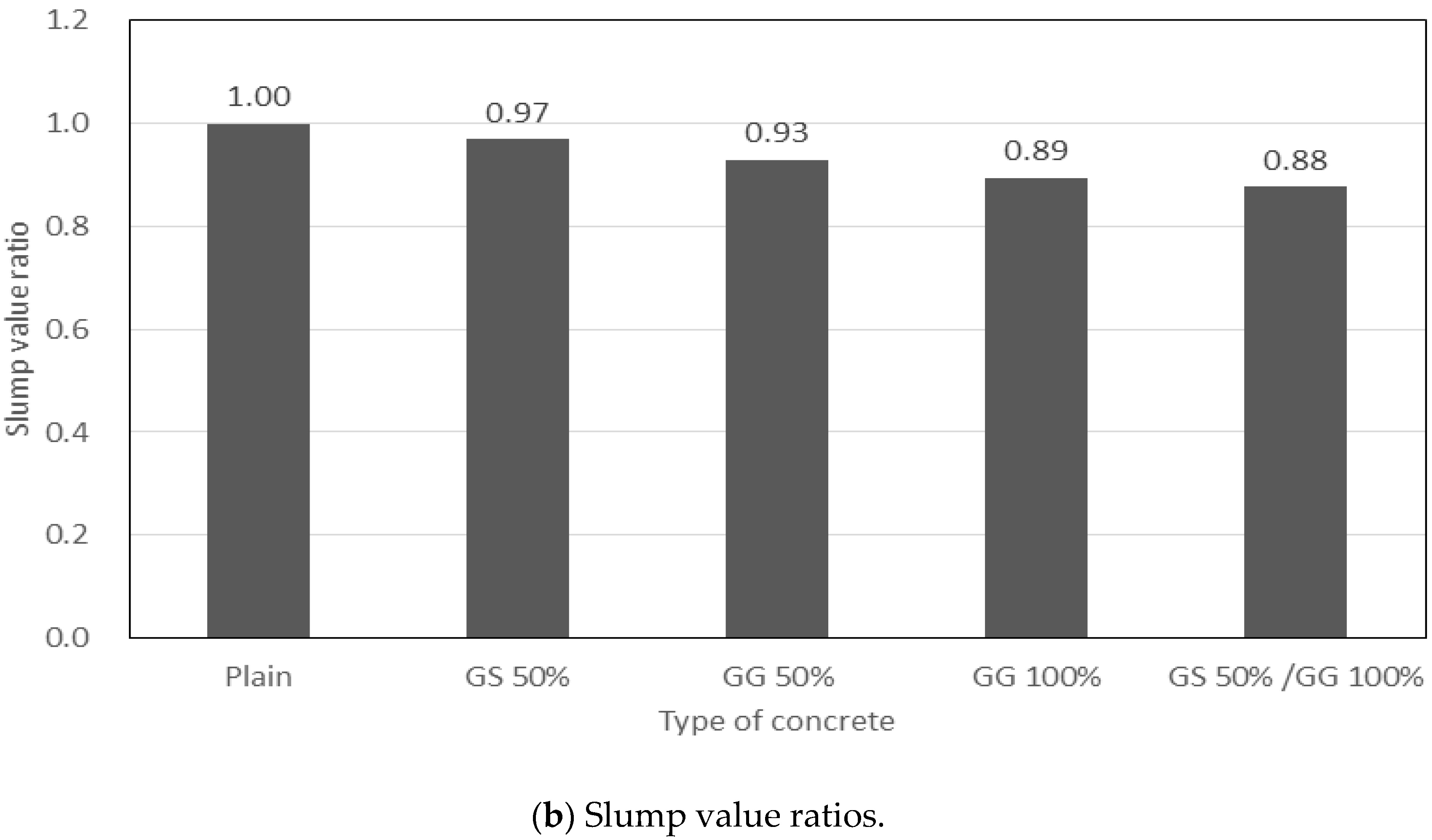
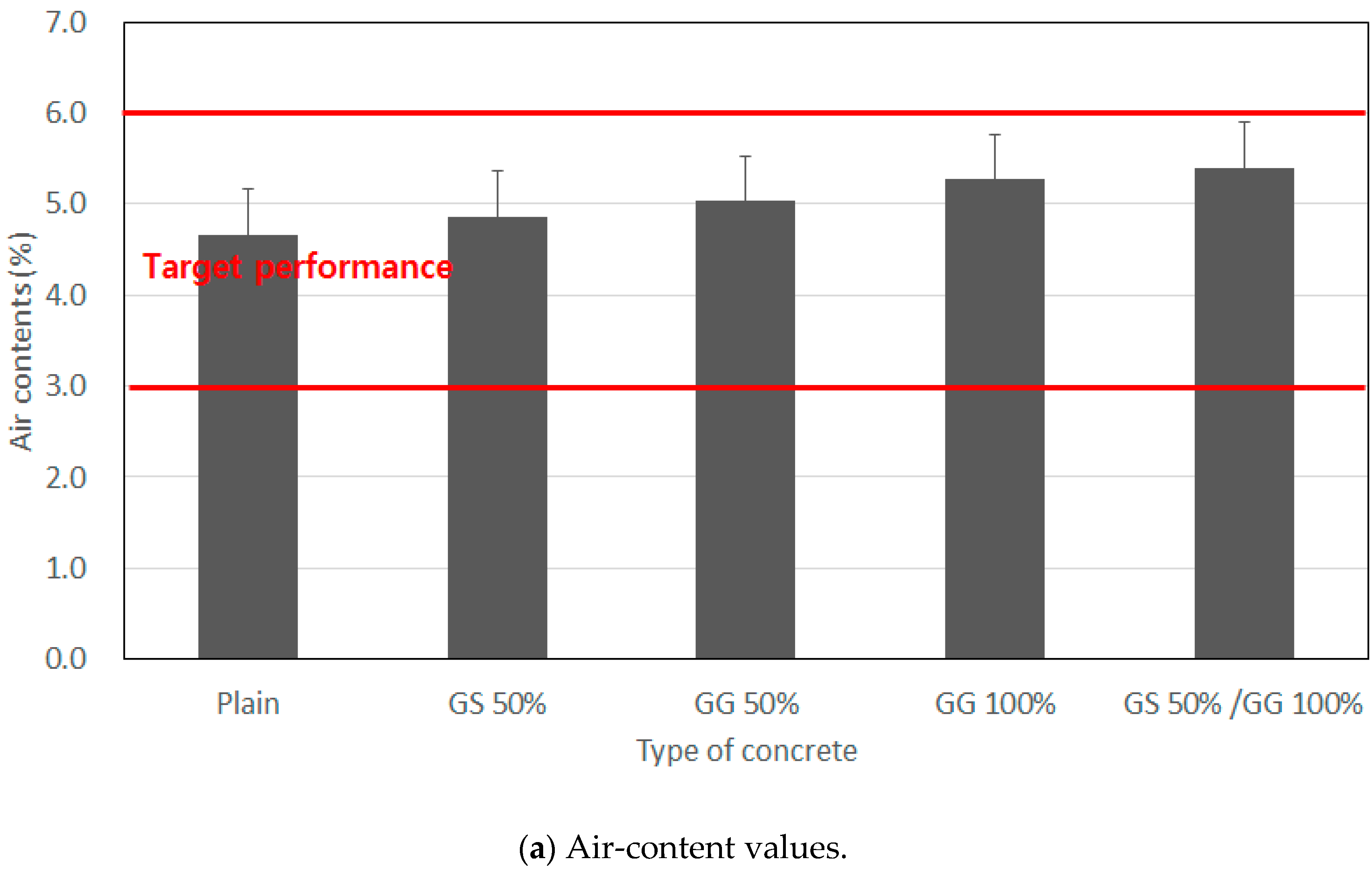


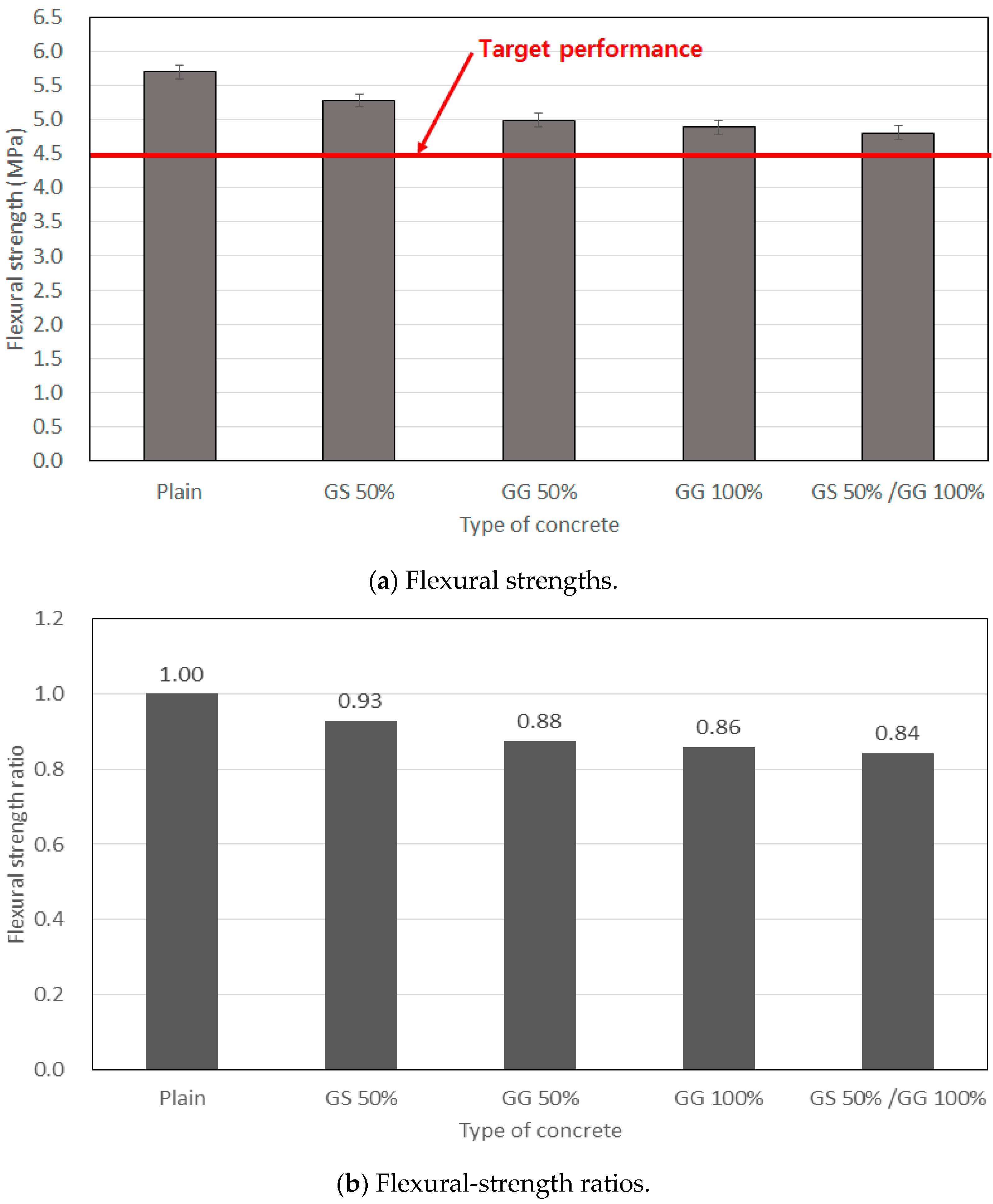
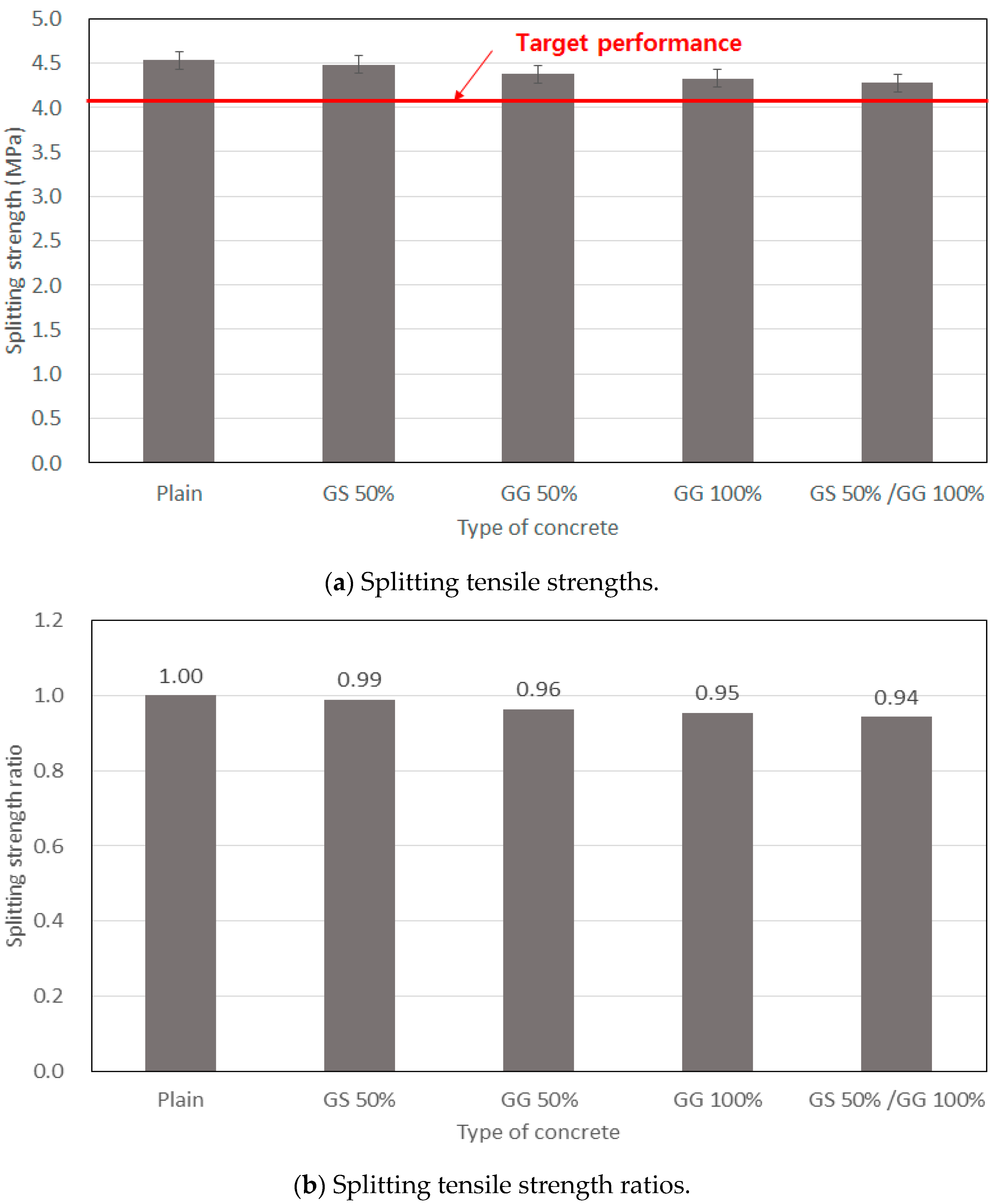
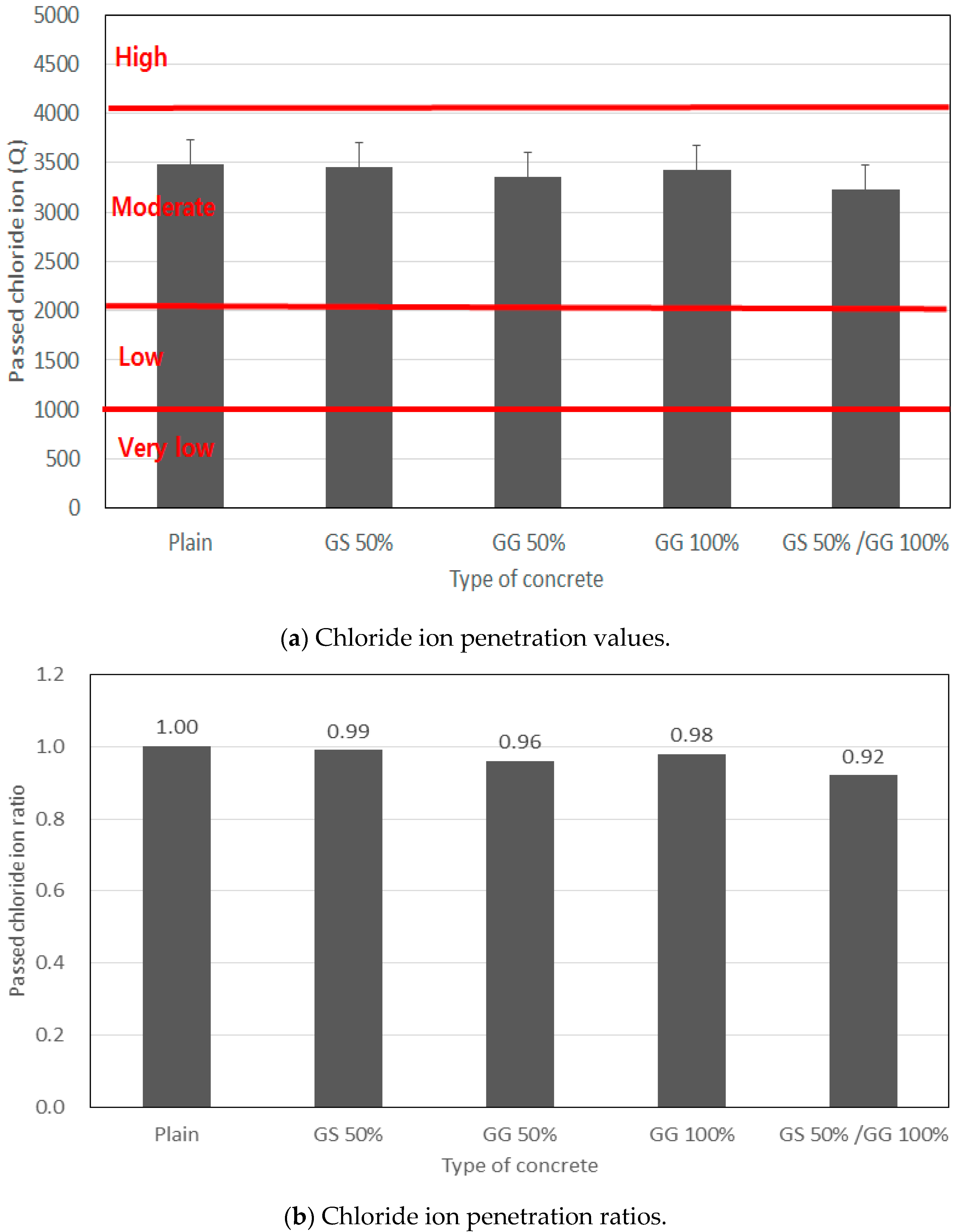
| Type of Cement | Fineness (cm2/g) | Specific Gravity | Stability (%) | Setting Time | Compressive Strength (MPa) | |||
|---|---|---|---|---|---|---|---|---|
| Initial (min) | Final (min) | 3 Days | 7 Days | 28 Days | ||||
| Type 1 Portland | 3200 | 3.15 | 0.02 | 220 | 400 | 20.3 | 30.2 | 38.7 |
| Density (g/mm3) | Fineness (cm2/g) | Absorption | L.O.I. * (%) | ||||
|---|---|---|---|---|---|---|---|
| 2.14 | 3400 | 0.13 | 3.28 | ||||
| Chemical compositions (%) | |||||||
| SiO2 | Al2O3 | Fe2O3 | CaO | MgO | Na2O | K2O | TiO2 |
| 58.12 | 23.56 | 7.69 | 2.59 | 1.12 | 0.31 | 1.42 | 1.05 |
| Density (g/mm3) | Fineness (cm2/g) | L.O.I. (%) | |||||
|---|---|---|---|---|---|---|---|
| 2.8 | 4000~6000 | 3.0 | |||||
| Chemical composition (%) | |||||||
| SiO2 | Al2O3 | Fe2O3 | CaO | MgO | MnO | TiO | S |
| 33.1 | 13.9 | 0.29 | 42.4 | 6.1 | 0.4 | 0.96 | 0.66 |
| Quality Items | Results |
|---|---|
| Fineness modulus | 2.72 |
| Density (g/mm3) | 2.58 |
| Water-absorption ratio (%) | 1.58 |
| 0.08 mm pass efficiency | 6.9 |
| Type of Aggregate | Density (g/mm3) | Absorption (%) | F.M. | ||
|---|---|---|---|---|---|
| Bulk | Bulk (SSD) | Apparent | |||
| Crushed coarse aggregate | 2.80 | 2.65 | 2.83 | 0.35 | 6.92 |
| Type | Color | Solids (%) | Density (g/mm3) | pH |
|---|---|---|---|---|
| Liquid | Light brown | ≥40 | 1.10~1.20 | 4.0~7.5 |
| Properties | Unit | Target Performance |
|---|---|---|
| Slump | Mm | ≥80 mm |
| Air contents | % | 4.5 ± 1.5 |
| Compressive strength | MPa | ≥21 |
| Splitting tensile strength | MPa | ≥4.2 |
| Flexural strength | MPa | ≥4.5 |
| Repeated freezing and thawing cycles (relative mechanical modulus) | % | ≥80% |
| Chloride ion penetration | Coulombs | <4000 |
| Item | Replacement Ratio of Air-Cooled Slag Aggregate | |
|---|---|---|
| Coarse Aggregate | Fine Aggregate | |
| Plain | 0% | 0% |
| GS 50% | 0% | 50% |
| GG 50% | 50% | 0% |
| GG 100% | 100% | 0% |
| GS 50%/GG 100% | 100% | 50% |
| Type of Mix | W/B (%) | S/a (%) | Unit Weight (kg/m3) | |||||||||
|---|---|---|---|---|---|---|---|---|---|---|---|---|
| W | C | BFS | FA | CS | SS | GS | G | GG | AD | |||
| Plain | 55.5 | 49.6 | 161 | 173 | 73 | 44 | 458 | 452 | - | 926 | - | 2.03 |
| GS 50% | 161 | 173 | 73 | 44 | 229 | 226 | 455 | 926 | - | 2.03 | ||
| GG 50% | 161 | 173 | 73 | 44 | 458 | 452 | - | 463 | 463 | 2.03 | ||
| GG 100% | 161 | 173 | 73 | 44 | 458 | 452 | - | - | 926 | 2.03 | ||
| GS 50%/GG 100% | 161 | 173 | 73 | 44 | 229 | 226 | 455 | - | 926 | 2.03 | ||
| Item | Component (%) | Fine Aggregate | |||||
|---|---|---|---|---|---|---|---|
| CaO | S | SO3 | FeO | Absolute Dry Density | Water Absorption Ratio | Unit Volume Weight | |
| Value | 40.81 | 0.00 | 0.39 | 1.19 | 2.77 | 1.57 | 1.70 |
| Item | Component (%) | Coarse Aggregate | |||||
|---|---|---|---|---|---|---|---|
| CaO | S | SO3 | FeO | Absolute Dry Density | Water Absorption Ratio | Unit Volume Weight | |
| Value | 40.81 | 0.00 | 0.39 | 1.19 | 2.49 | 4.28 | 1.41 |
| Item | Cd | Pb | Cr+6 | As | Hg | Se | F | B |
|---|---|---|---|---|---|---|---|---|
| Elution standard | 150 | 150 | 250 | 150 | 15 | 150 | 4000 | 4000 |
| Value | 0.9233 | ND | ND | 0.3 | ND | 3.633 | 107.17 | 68.61 |
| Item | Pb | Cu | As | Hg | Cd | Cr+6 | CN |
|---|---|---|---|---|---|---|---|
| Elution standard | 3 | 3 | 1.5 | 0.005 | 0.3 | 1.5 | 1 |
| Value | ND | 0.0012 | ND | ND | ND | ND | 0.0025 |
Publisher’s Note: MDPI stays neutral with regard to jurisdictional claims in published maps and institutional affiliations. |
© 2021 by the authors. Licensee MDPI, Basel, Switzerland. This article is an open access article distributed under the terms and conditions of the Creative Commons Attribution (CC BY) license (https://creativecommons.org/licenses/by/4.0/).
Share and Cite
Ahn, B.-H.; Lee, S.-J.; Park, C.-G. Physical and Mechanical Properties of Rural-Road Pavement Concrete in South Korea Containing Air-Cooled Blast-Furnace Slag Aggregates. Appl. Sci. 2021, 11, 5645. https://doi.org/10.3390/app11125645
Ahn B-H, Lee S-J, Park C-G. Physical and Mechanical Properties of Rural-Road Pavement Concrete in South Korea Containing Air-Cooled Blast-Furnace Slag Aggregates. Applied Sciences. 2021; 11(12):5645. https://doi.org/10.3390/app11125645
Chicago/Turabian StyleAhn, Byung-Hwan, Su-Jin Lee, and Chan-Gi Park. 2021. "Physical and Mechanical Properties of Rural-Road Pavement Concrete in South Korea Containing Air-Cooled Blast-Furnace Slag Aggregates" Applied Sciences 11, no. 12: 5645. https://doi.org/10.3390/app11125645





